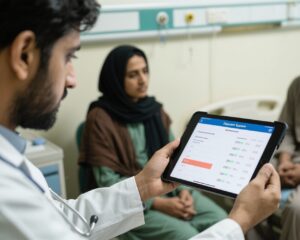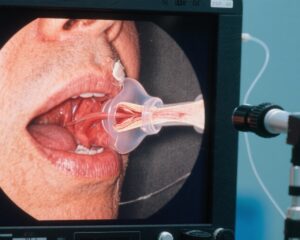Highlight
1. In a randomized trial involving 20,509 adults aged 45 to 49 years, usual care with mailed fecal immunochemical test (FIT) outreach led to a significantly higher screening participation (26.2%) compared to three active choice strategies (14.5% to 17.4%).
2. Offering a dual-modality active choice between FIT or colonoscopy modestly improved screening completion compared to a single active choice intervention.
3. Colonoscopy was the preferred modality when participants chose between FIT and colonoscopy in the dual-modality arm, yet notable crossover from FIT to colonoscopy occurred across groups.
Study Background and Disease Burden
Colorectal cancer (CRC) remains a leading cause of cancer morbidity and mortality worldwide. Due to shifting epidemiology and increasing incidence among younger adults, recent guidelines by the U.S. Preventive Services Task Force recommend beginning average-risk CRC screening at age 45 years instead of 50. However, how best to promote screening uptake in this younger cohort remains unclear. Effective outreach and engagement strategies are crucial to maximizing early detection and ultimately improving survival outcomes. Traditional approaches have relied on mailed FIT kits, colonoscopy scheduling, and patient education, but the comparative effectiveness of proactive patient choice models versus usual care in this age group warrants further investigation.
Study Design
This randomized clinical trial was conducted within the UCLA Health system from May 2 to May 13, 2022, with follow-up through November 13, 2022. A large cohort of 20,509 average-risk primary care patients aged 45 to 49 years were randomized 1:1:1:1 into four outreach arms:
- FIT-only active choice: Participants actively invited to complete a FIT with an option to decline or request colonoscopy.
- Colonoscopy-only active choice: Participants actively invited to schedule colonoscopy with an option to decline or request FIT instead.
- Dual-modality active choice: Participants presented with the option to choose either FIT or colonoscopy.
- Usual care: Default mailed FIT outreach without active choice framing.
The primary outcome was CRC screening participation within 6 months, defined as completing either FIT or colonoscopy. Secondary outcome focused on the specific screening modality completed.
Key Findings
Overall screening participation was modest, with 18.6% (3,816/20,509) of participants completing screening within 6 months.
Screening Rates by Group:
- Usual care mailed FIT: 26.2% (1,342/5,126)
- FIT-only active choice: 16.4% (841/5,131); rate difference vs usual care, -9.8% (95% CI, -11.3% to -8.2%); P < .001
- Colonoscopy-only active choice: 14.5% (743/5,127); rate difference vs usual care, -11.7% (95% CI, -13.2% to -10.1%); P < .001
- Dual-modality active choice (FIT or colonoscopy): 17.4% (890/5,125); rate difference vs usual care, -8.9% (95% CI, -10.5% to -7.4%); P < .001
Notably, participants offered a choice between FIT and colonoscopy (dual-modality arm) had a slightly higher screening completion compared to the combined rate of the single-modality arms (17.4% vs 15.4%; rate difference, -1.8%; 95% CI, -3.0% to -0.1%; P = .004).
Modality Preferences and Crossovers:
- In the dual-modality active choice group, colonoscopy was twice as commonly completed as FIT (12.0% vs 5.6%; rate difference, -6.4%; 95% CI, -7.5% to -5.3%; P < .001), suggesting a preference for colonoscopy when given the option.
- Despite the FIT-only active choice, nearly 9.8% of participants crossed over to complete colonoscopy, mirroring a similar crossover rate in the usual care group.
- Crossover from colonoscopy-only active choice to FIT was modest, at 2.7%.
These findings suggest that actively prompting participants to choose screening modalities paradoxically reduced overall participation compared to a default mailed FIT approach, which is notable given the assumption that patient choice typically enhances engagement.
Expert Commentary
This large pragmatic trial offers valuable insights into colorectal cancer screening strategies for younger adults newly eligible under updated guidelines. The study challenges the common assumption that provision of active choice inherently increases screening uptake, at least in this demographic and context. Several factors may explain the lower participation in active choice arms, including possible decision fatigue, increased decisional complexity, or psychological resistance to making active health decisions without direct provider engagement.
The preferential selection of colonoscopy when multiple options were provided aligns with previous research indicating patient perception of colonoscopy’s thoroughness despite its higher invasiveness and preparatory burden. Interestingly, significant crossover to colonoscopy from FIT-only outreach could reflect participant preference for direct visualization or confidence in colonoscopy efficacy.
Limitations of the study include its confinement to a single health system, which may affect generalizability, and the relatively short follow-up period. Nonetheless, the large sample size and randomized design strengthen validity. Future research might explore integration of personalized decision aids, physician-led counseling, or digital engagement tools to better support younger adults in cancer screening decisions.
Conclusion
This pragmatic randomized clinical trial finds that usual care with default mailed FIT outreach leads to higher colorectal cancer screening completion than engaging participants through active choice invitations for FIT, colonoscopy, or both in adults aged 45 to 49 years. The findings underscore the challenges of increasing screening participation in younger populations despite guideline expansions and suggest that simpler outreach methods may remain more effective than complex choice environments.
Clinicians and population health managers should consider maintaining streamlined mailed FIT programs while researching supplementary strategies to enhance informed uptake of colorectal cancer screening in this target age group. Addressing patient barriers and decision-making processes remains essential to improving prevention efforts and early detection in colorectal cancer.
References
- Galoosian A, Dai H, Croymans D, et al. Population Health Colorectal Cancer Screening Strategies in Adults Aged 45 to 49 Years: A Randomized Clinical Trial. JAMA. 2025;334(9):778-787. doi:10.1001/jama.2025.12049.
- US Preventive Services Task Force. Screening for Colorectal Cancer: US Preventive Services Task Force Recommendation Statement. JAMA. 2021;325(19):1965-1977. doi:10.1001/jama.2021.6238.
- Shaukat A, Mongin SJ, Geisser MS, et al. Long-Term Mortality After Screening for Colorectal Cancer. N Engl J Med. 2013;369(12):1106-1114. doi:10.1056/NEJMoa1300720.



